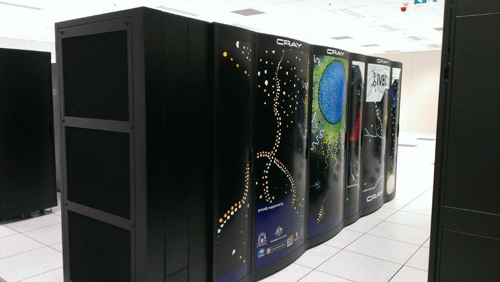ASKAP processing capabilities scaled up
The Australian Square Kilometre Array Pathfinder telescope makes use of innovative Phased Array Feed (PAF) technology to produce radio images that cover wide regions of the sky. This gives ASKAP the ability to conduct rapid surveys that greatly increase our knowledge not only of the static (unchanging) aspects of our universe (the location, brightness, etc. of many galaxies outside our own) but also the dynamic aspects (transient events like extreme scattering episodes, fast radio bursts, etc.).
However, this new capability also increases the rate at which ASKAP generates data by a factor of roughly the number of beams formed (36) over a more traditional single-feed telescope array. The end result is that the computational processing required to generate images from the raw data poses a significant challenge.

Pawsey Supercomputing Centre, Perth, Western Australia
High-performance computing was designed into ASKAP's operational framework from the very beginning, using systems maintained by our Western Australian partners, the Pawsey Supercomputing Centre.
Pawsey hosts several supercomputer systems including one called Galaxy, which is a key part of the ASKAP real-time data processing pipeline. Custom-designed CSIRO hardware at the observatory, correlates the signals from each of the 36 ASKAP antennas with each other in real time, producing roughly 2.5 GB of data every second when fully operational.
This is transmitted down an optical fibre link provided by AARNET, ending up at a series of high-speed intake computers that format the data and pass it on to the rest of the supercomputer for imaging.
During our commissioning and early science phase, we are tuning the precise algorithms used to make images from the raw data and it is very beneficial to store the data on disk so it can be reprocessed several times. This allows the image quality to be assessed by our survey science teams and improved before the final images are archived and released to the public. In order to do this, we need a large amount of disk space to cope with the incoming data rate.
In order to help address the growing needs of ASKAP and other telescopes hosted at the Murchison Radio Observatory (including the Murchison Wide-field Array), Pawsey recently installed and commissioned a new storage system specifically for astronomical use.
The system is an SGI/HPe cluster that provides approximately 1.9 PB (1.9 million Gigabytes) of disk-based storage that will be used for raw data and intermediate processing. The Galaxy supercomputer now provides ASKAP scientists access to processing power equal to 200 trillion computations per second.

Pawsey's Galaxy 1
The new file system is being integrated with two of the most powerful supercomputers at Pawsey and has already significantly eased the congestion caused by multiple users processing the existing early science data.
The new storage system uses a high-performance file system known as Lustre, giving it a theoretical read/write speed of over 10 GB per second, with built-in redundancy to ensure maximum availability. It is also fully upgradeable, allowing additional space to be added easily in future.
Industry partnerships such as the CSIRO-Pawsey arrangement are critical to the success of large-scale facilities like ASKAP and the MRO.
